


|
5 avril 2001, Dominic Hughes à Sydney pour
BBC News |
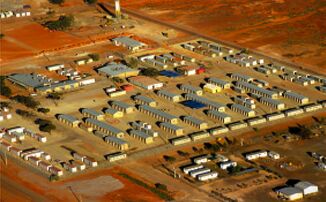 |
|
| http://news.bbc.co.uk/1/hi/world/asia-pacific/1262393.stm |
" Human rights groups and asylum seekers have repeatedly
criticised conditions at Australia's detention centres for illegal immigrants.
Many of the centres are in extremely remote areas, meaning that legal help
is hundreds of kilometres away.
… For Immigration Minister Philip Ruddock this is a bonus - it means
that no one would try and escape when faced with a big, empty desert. But
the location also made visits by family members extremely difficult and
raised concerns that the illegal immigrants were being keep out of sight
of an inquisitive local media.
Intense heat
At the Woomera detention centre, a former missile base in South Australia, there were initial fears that the detainees, including women and children, would suffer in the intense heat of summer. These fears were allayed to some degree by the announcement that air conditioning had been installed in the prefabricated buildings used for accommodation. But temperatures at Woomera and some of the other detention centres can easily exceed 40 degrees centigrade in summer.
| … A United Nations committee has also criticised the delays in the decision making process, as well as the policy of imprisoning women and children. Australia was accused of failing to honour its commitments to international treaties it had signed on the treatment of refugees. Meanwhile ministers argue that asylum seekers and other illegal immigrants are always held in humane conditions, often better than those they came from. The centres, if not comfortable, are adequate, and allow officials to process claims quickly and efficiently. They also ensure the residents do not disappear into the community. … " |
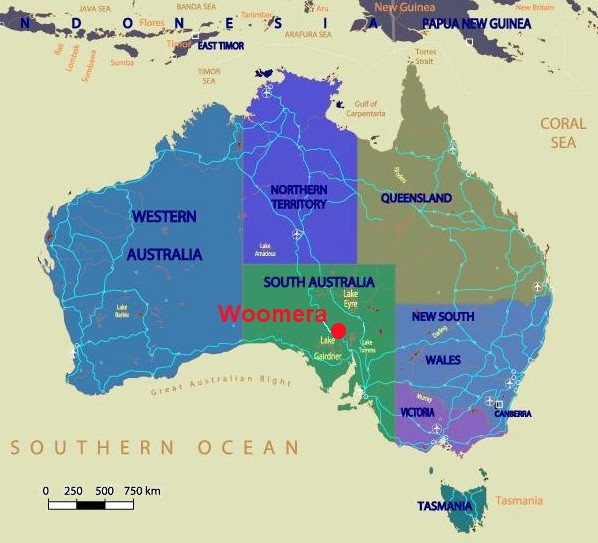 |
|
19 décembre 2001, Pam O'Toole pour BBC news
Australia's detention centre in the desert
http://news.bbc.co.uk/1/hi/world/asia-pacific/1719808.stm
" Australia has traditionally been generous
when it comes to resettling people already recognised as refugees elsewhere.
But people arriving there illegally to claim asylum find themselves facing
one of the toughest regimes in the world. While their cases are being assessed
they are automatically detained in one of six detention centres scattered
across Australia.
| Woomera - the largest, with just under 1,000 inhabitants - is also perhaps the most remote. Surrounded by barbed wire and several layers of fencing, it is situated in a former rocket testing range in the barren and dusty South Australian desert, almost 300 miles away from Adelaide. … The centre was established on government land in 1999 to cope with a sudden influx of asylum seekers arriving illegally by boat. |
 |
|
As the number of such arrivals increased to around 5,000
per year, the original facilities were expanded and improved. Portable buildings
were brought in containing new, air-conditioned accommodation. Some play
equipment was brought in for child detainees. But Woomera remains a bleak
place, with little for inmates to do. When I visited there in March, the
detainees - mostly Afghans - shuffled around aimlessly, or squatted under
the canvas awnings provided.
Afghans are by far the largest group in Australia's
immigration detention centres, making up more than a quarter of the inhabitants.
Other major groups include Iraqis - around 13% of the centre's population
- and Iranians at around 7%. While most inmates have their cases processed
in a matter of months, some can be incarcerated for several years. Over
the past 18 months there has been an increasing wave of discontent in these
centres. Woomera has suffered more incidents than most; Canberra says there
have been eight fire-related incidents there in the past month. "
19 décembre 2001, Yahoo news
Nouvelle nuit d'émeute de demandeurs d'asile en Australie
http://fr.news.yahoo.com/
" CANBERRA (Reuters) - Pour la seconde
nuit consécutive, des demandeurs d'asile ont mis le feu à
des bâtiments dans un centre de rétention australien, rapportent
les autorités.
Des centaines d'immigrés clandestins ont jeté des pierres
sur le personnel et certains d'entre eux ont tenté de franchir la
clôture d'enceinte jusqu'à l'arrivée de renforts de
sécurité. Ce matin, la situation au centre de Woomera, le
plus isolé d'Australie, était qualifiée de calme et
on ne signalait aucun blessé, mais le personnel reste en état
d'alerte. Les clandestins demandeurs d'asile en Australie sont automatiquement
placés dans des centres de rétention - y compris les femmes
et les enfants - le temps que leur demande soit examinée, ce qui
peut prendre plusieurs années avec les procédures d'appel.
L'Attorney general Daryl Williams a déclaré que des poursuites
seraient engagées contre une partie des 949 demandeurs d'asile de
Woomera, originaires pour la plupart du Moyen-Orient. D'autres ont au contraire
participé à la lutte contre les incendies allumés dans
cinq bâtiments dans la nuit de mardi à mercredi, et dans 15
bâtiments la nuit précédente. Les tensions sont plus
vives à Woomera que dans les autres centres en raison de la situation
du camp en plein désert, à 475 km au nord d'Adelaide. "Dans
ce type d'environnement, les gens perdent toute notion d'espoir, en particulier
quand ils ne savent absolument pas combien de temps ils y resteront",
a dit à Reuters Margaret Piper, directrice du Conseil des réfugiés
d'Australie. "
25 janvier 2002, Phil Mercer pour BBC News
Death watch in the outback
http://news.bbc.co.uk/1/hi/world/asia-pacific/1782654.stm
" One activist has told the BBC it is
only a matter of time before someone inside Woomera dies as a result of
the standoff with the immigration authorities.
|
… |
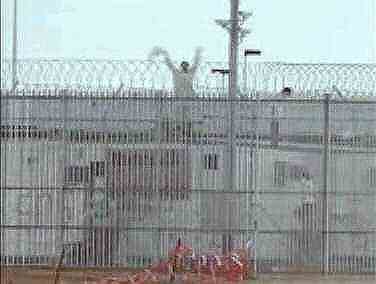 |
The Prime Minister, John Howard, has insisted his government
will not buckle under what he called the moral intimidation by the hunger-strikers
at Woomera. Once again, this tiny outback settlement is the focus of world
attention. It has become something of a tourist attraction, too. Backpackers
have been having their photos taken outside the gates. "
30 janvier 2002, Courrier International du 30/1/2002
L'Australie a honte de Woomera
http://www.courrierinternational.com/
" En grève de la faim depuis seize
jours, les réfugiés, pour la plupart afghans, regroupés
au centre de détention de Woomera ont mis fin à leur mouvement.
Le gouvernement australien s'est engagé à traiter leur demande
d'asile dans les plus brefs délais.
A Woomera, l'espoir renaît. Les réfugiés, à majorité afghans, regroupés par le gouvernement australien dans cette ancienne base militaire du désert d'Adélaïde ont annoncé la fin de leur mouvement. Le refus des autorités australiennes de considérer leur demande d'asile avait provoqué, il y a seize jours, une grève de la faim. … "
| 30 Janvier 2002, ABC News http://www.abc.net.au/news/indepth/yir2002/text/default.htm " A hunger strike at the Woomera Detention Centre ends after a protest spanning 15 days. At its height more than 200 hundred detainees are involved, with scores sewing their lips shut and a group of nine teenagers threatening suicide. " |
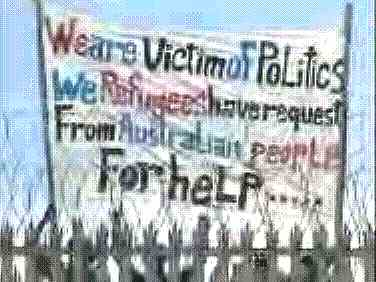 |
|
5 février 2002, Article de Frédéric
Therin Le monde du 05.02.02
Grève
de la faim à Woomera
" … Venus pour beaucoup d'Irak et
d'Afghanistan, les clandestins trouvent à leur arrivée sur
la terre australienne un asile carcéral humiliant et dissuasif.
Seize jours. Il aura fallu seize jours de grève de la faim de plusieurs
centaines de demandeurs d'asile du camp de détention de Woomera,
un coin perdu dans le désert, à 600 kilomètres au nord
d'Adélaïde, dans l'Etat d'Australie-Méridionale, pour
que le gouvernement fédéral accepte de relancer l'étude
des dossiers des clandestins en provenance d'Afghanistan. Depuis la déroute
des talibans, ces formulaires avaient été mis de côté
en raison de l'amélioration de la situation politique en Asie du
Sud. Entre 259 et 376 détenus (si l'on en croit les chiffres officiels
ou ceux divulgués par leurs avocats) ont décidé, pour
protester, de ne plus prendre leurs repas. Près d'une cinquantaine
de personnes se sont même cousu les lèvres, et un homme s'est
blessé grièvement en se jetant sur des fils de fer barbelés
du haut du grillage entourant Woomera. Le premier ministre confédéral,
le conservateur John Howard, a proposé fin janvier de verser une
aide financière à tous les Afghans détenus en Australie
qui accepteraient de rentrer dans leur pays. … "
|
Dans les évenements marquants
de l'année 2002, ABC news souligne les importantes manifestations
de soutien aux détenus de Woomera en Mars 2002
http://www.abc.net.au/news/indepth/yir2002/text/default.htm 29 March 2002: Up to 1,000 protesters storm the Woomera Detention Centre, tearing down razor wire and helping almost 50 detainees escape. |
 |
|
 |
22 avril 2002, ABC News
Detainees refuse to surrender weapons
http://www.abc.net.au/news/2002/04/item20020422000128_1.htm
" Immigration officials have failed to persuade a group of detainees
at the Curtin Detention Centre in northern Western Australia to surrender
all their weapons. Tensions at Curtin have been high since Friday's riot,
in which a number of people were injured. Overnight, some detainees set
fire to the centre's welfare room, causing extensive damage. … "
Dans les évènements marquants de
l'année 2002, ABC news évoque l'affaire des frères
Bakhtiyari
http://www.abc.net.au/news/indepth/yir2002/text/default.htm
18 July 2002: The 13- and 12-year-old Bakhtiyari brothers are refused asylum
by the British consulate in Melbourne and are returned to the Woomera Detention
Centre. Their father Ali is now in the Villawood centre after his temporary
protection visa was cancelled.
3 février 2003, Phil Mercer pour BBC News
Australian asylum seekers escape
http://news.bbc.co.uk/1/hi/world/asia-pacific/2719547.stm
" Six asylum seekers have escaped from the troubled
Woomera detention centre in Australia. Immigration authorities have said
guards were attacked and injured in the break-out. Woomera was the scene
of a mass break-out last March. It is claimed the escape was organised by
a group of activists wearing balaclavas. The group tore down part of a perimeter
fence at the remote desert facility before disappearing with the asylum
seekers. Australian police said this was a well-planned escape.
…
The camp at Woomera is slowly being decommissioned. Many of its detainees
have been transferred to the new Baxter facility near Port Augusta, 300
kilometres north of Adelaide, where many are facing deportation. "
6 février 2003, ABC NEWSonline
Seventh person detained over Woomera breakout
http://www.abc.net.au/news
" South Australian police say all six detainees
who escaped from the Woomera detention centre on Monday, have now been recaptured
but they have also arrested a seventh person, whose status is unknown. Yesterday
afternoon South Australian police thought they had arrested all six of those
who broke out of the Woomera centre in the Burra area, 150 kilometres north
of Adelaide. … "
* Les centres de détentions pour les
migrants illégaux en Australie
Un plan de Woomera avec le Sydney Morning Herald du 29 janvier
2002
http://www.smh.com.au/news/0201/29/national/graphic1.html
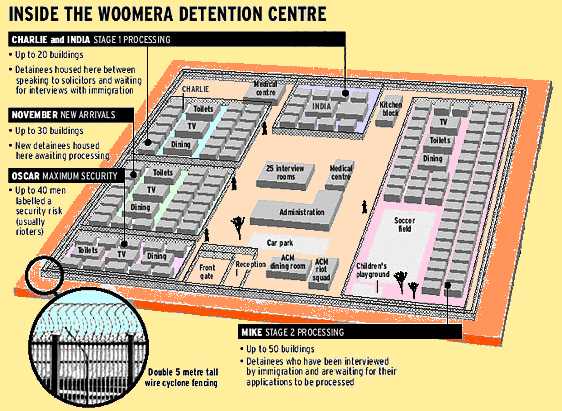 |
||
Le Refugee Action
Committee - Australia nous donne des chiffres sur le nombre de personnes
dans les différents centres de détention pour migrants illégaux
en Australie.
http://www.refugeeaction.org/where.php
 |
||
|
Une carte réalisée au CTIG de l'Université de La Rochelle pour " australie.recherche.fr " |
The Department of Immigration
and Multicultural and Indigenous Affairs (DIMIA ou parfois simplement
DIMA) nous donne des précisions sur les centres de détention
pour migrants illégaux en Australie.
http://www.immi.gov.au/illegals/border2000/border32.htm
" In 1999-2000, the high number of unauthorised boat arrivals
led to the reopening of the Curtin centre in Western Australia, and the
establishment of a facility in Woomera, South Australia. Other detention
centres have been operating close to capacity. In response, as part of the
2000-01 Commonwealth Budget initiatives, the Government has allocated funding
to expand and upgrade DIMA's detention facilities.
In a long-term strategy, new detention facilities will be built in Brisbane
and Darwin, and additional detention capacity will be developed in Melbourne,
Perth and Sydney.
Unlawful non-citizens are currently detained in one of six immigration detention
facilities maintained by DIMA:
* Villawood Immigration Detention Centre (IDC) in Sydney,
established in 1976;
* Maribyrnong IDC in Melbourne, established in 1966;
* Perth IDC, established in 1981;
* the Immigration Reception and Processing Centre (IRPC) in Port Hedland,
Western Australia, established in 1991;
* Curtin IRPC in Derby, Western Australia, recommissioned in September 1999;
and
* Woomera IRPC in Woomera, South Australia, commissioned in November 1999.
"
The Department of Immigration and Multicultural and Indigenous
Affairs nous précise par ailleurs sur son site que :
" A review of detention facilities was completed in 2002, and will
result in a number of changes - New facilities are to be established at
Port Augusta, SA, Pinkemba, Qld and at Christmas Island . "
http://www.immi.gov.au/detention/facilities.htm
Article
"Réfugiés en Australie" de Frédéric
Therin paru dans Le monde du 05.02.02
sur les centres de détention
" … En janvier 2002, 2 736 personnes étaient détenues
dans un des six centres qui sont gérés, depuis septembre 1997,
par l'Australasian Correctional Management (ACM), une filiale du groupe
américain Wackenhut qui manage cinquante-cinq prisons dans sept pays.
Parmi ces détenus figuraient 582 mineurs dont 53 enfants non accompagnés.
Dans le camp de Villawood à Sydney, 20 % des 503 détenus sont
emprisonnés depuis plus d'un an. A Port Hedland, dans l'Etat d'Australie-Occidentale,
6 % des 440 demandeurs d'asile sont écroués depuis plus de
deux ans. "Les règles dans ce pays sont plus strictes que dans
n'importe quel pays européen, se lamente Margaret Piper, directrice
du Conseil du réfugié d'Australie, organisation non gouvernementale
qui étudie les problèmes d'immigration. Pour le pouvoir en
place, tous les moyens sont bons pour dissuader les émigrants de
venir ici. … "
En relation avec le sujet
on pourra consulter sur le site "australie.recherche.fr"
la Page Août 2001
- L'épopée du Tampa au large de L'Australie
la Page Septembre 2001
- L'installation des réfugiés du Tampa à Nauru
la Page Décembre
2001 - Naissance de la "Solution Pacifique"
la Page Juin 2002
- L'Australie moins accueillante avec les boatpeople